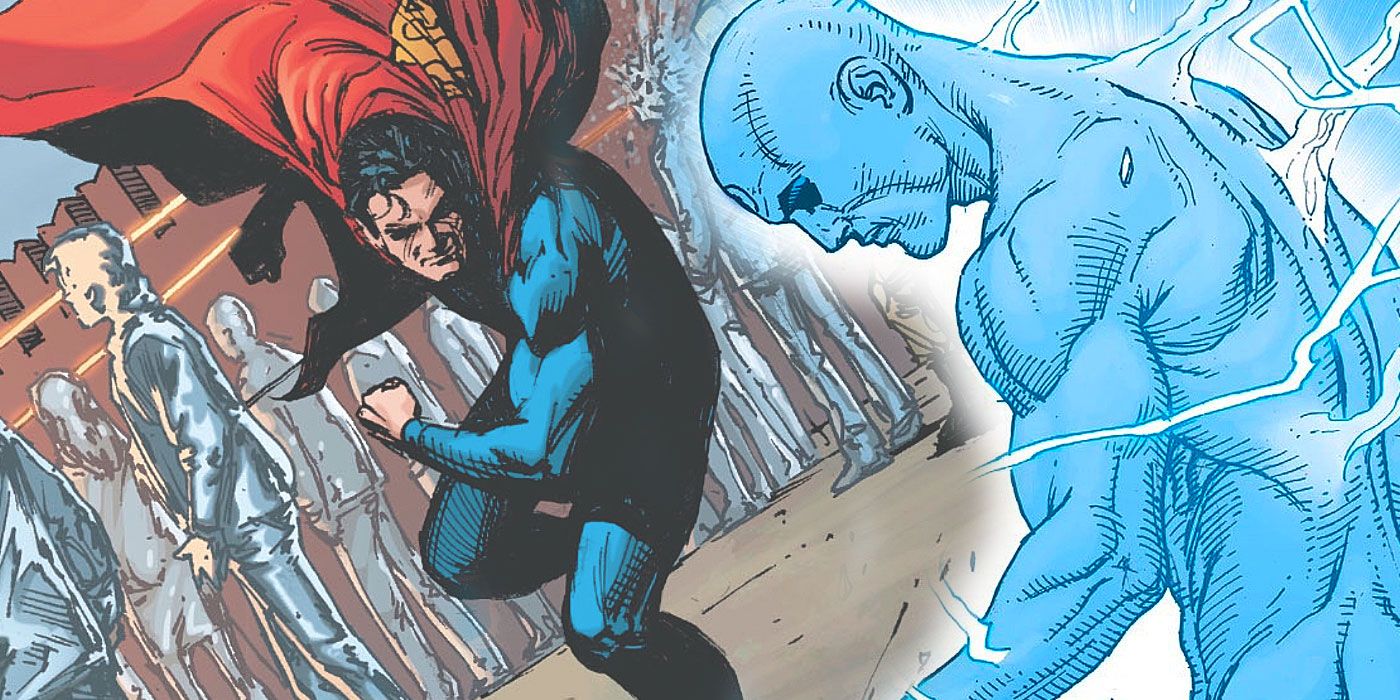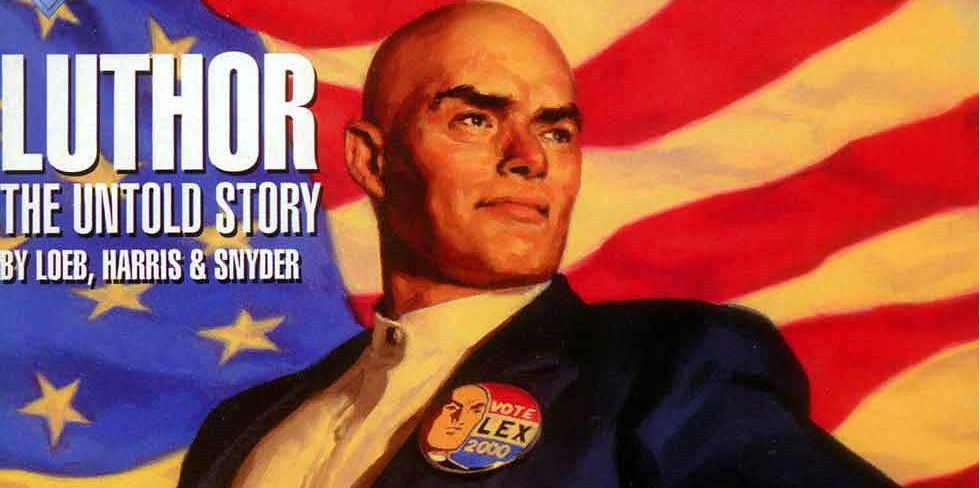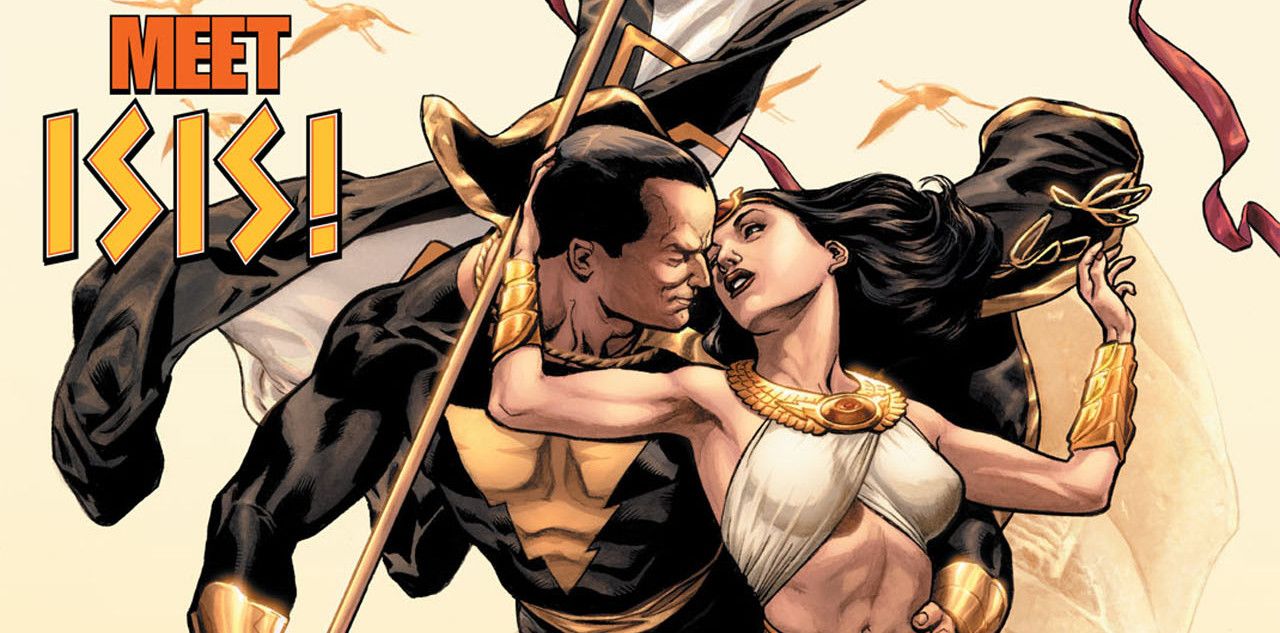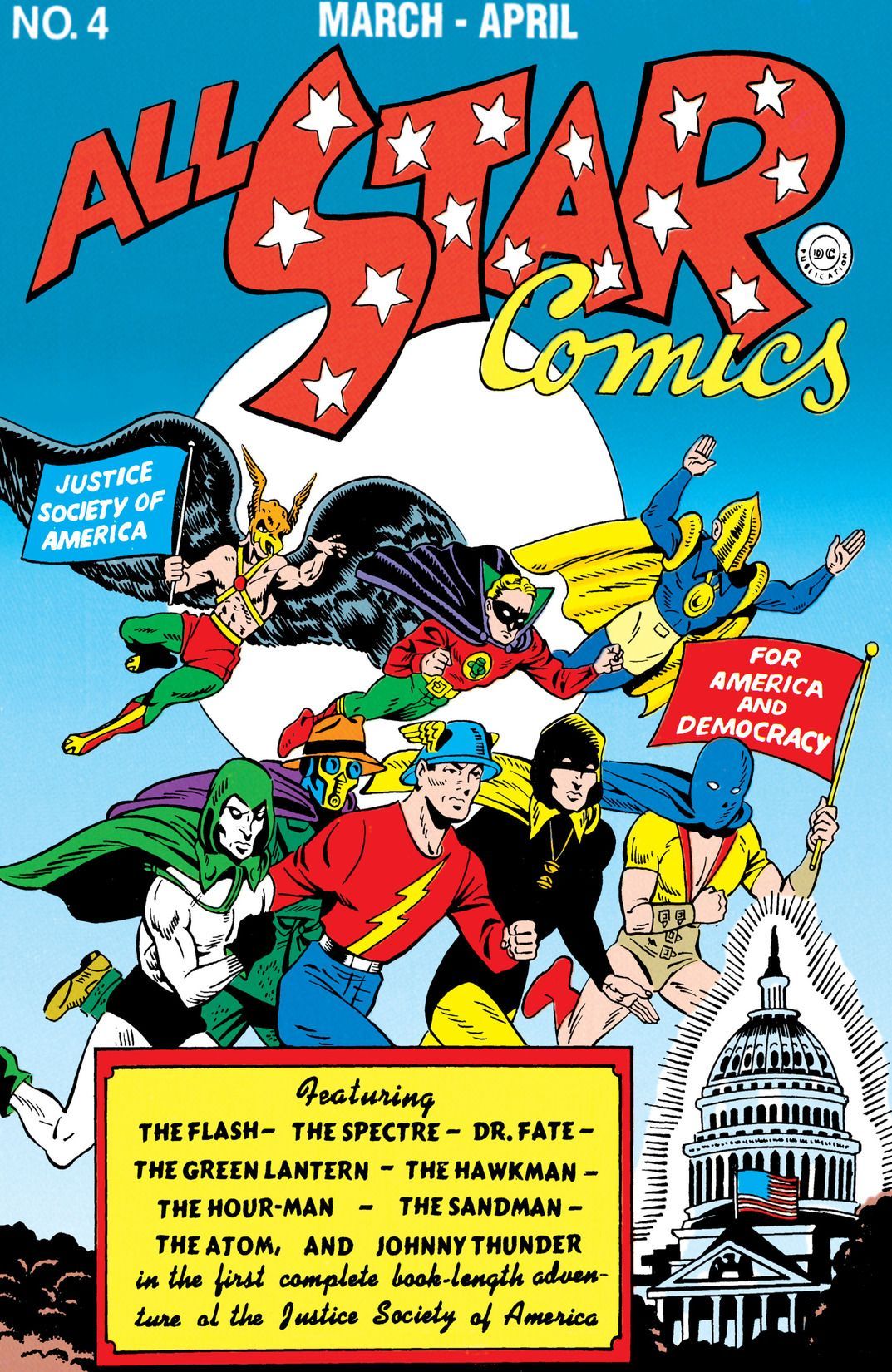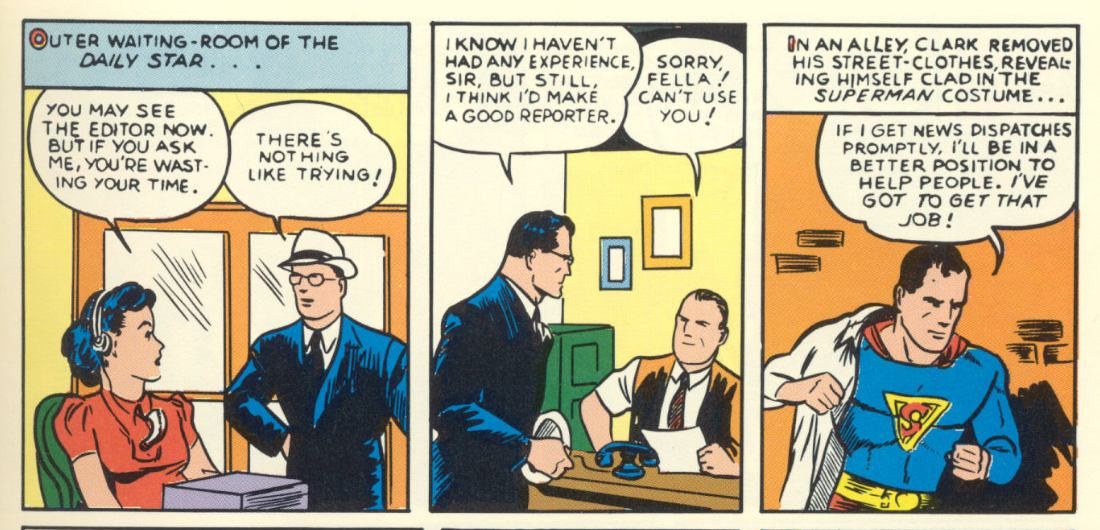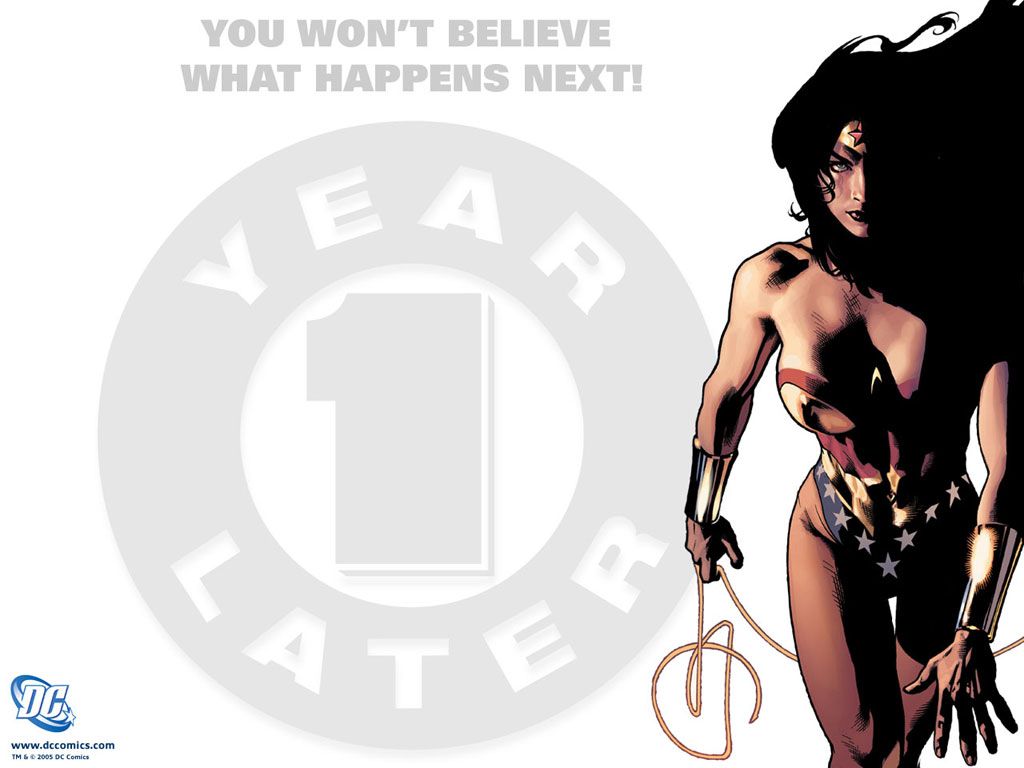[WARNING: This post contains SPOILERS for Doomsday Clock #8 by Geoff Johns and Gary Frank, on sale now.]
As Doomsday Clock hits the two-thirds point, the endgame isn't much clearer but the sense of looming dread remains. Because Issue #8 focuses almost exclusively on DC-Earth superheroes, in some ways it is the least Watchmen-esque installment so far. Arguably, though, that gives the issue's events even more impact.
In putting together these annotations, we noticed a lot of characters and situations were set up back in issue #5, so this may be a good time to catch up on the miniseries so far, and that issue in particular. We don't think it's too spoilerrific to say that, although by this point we shouldn't have to warn you there will be plenty of spoilers from here on out.
Doomsday Clock issue #8 was written by Geoff Johns, drawn by Gary Frank, colored by Brad Anderson and lettered by Rob Leigh. Amie Brockaway-Metcalf designed the text pages. Brian Cunningham was the Editor, with Amedeo Turturro as Associate Editor. As if you didn't know, it is based in no small part on Alan Moore and Dave Gibbons' Watchmen.
Obvious Watchmen Content (Pages 1, 3, 6)
Ozymandias is in the Oval Office on Page 1. The 2008 miniseries DC Universe: Decisions showed Martin Suarez, a Democrat, being elected President of DC-Earth's United States. However, as of July 2011's Action Comics issue #901, the President was Barack Obama. While DC is not as world-outside-your-window as Marvel, its in-universe POTUSes have been both real and fictional. Just off the tops of our heads, we know that John F. Kennedy, Ronald Reagan and Bill Clinton each appeared in DC books published during their respective terms of office. However, starting with President Lex Luthor in 2000, DC went through a series of fictional leaders of the free world, including Pete Ross and Jonathan Horne. This may mean that George W. Bush was never President on DC-Earth, which kind of blows our minds. Anyway, since DC-Earth also has to deal with an elastic timeline, we're not sure who's POTUS during Doomsday Clock.
Page 3 contains the first of two hard-to-miss Watchmen callbacks. Last issue Rorschach mailed his predecessor's diary to Lois Lane, and this issue she reaches for it, not unlike the New Frontiersman's Seymour at the end of Watchmen issue #12. Likewise, when the overstressed Firestorm unloads on hapless Muscovites on Page 6, it's a clear reference to Doctor Manhattan's outburst in Watchmen issue #3.
NEXT PAGE: Doomsday Clock #8: Superman Faces Down Black Adam
Black Adam And Big Blue (Pages 9, 11-12)
On Page 9 we see the Creeper for the first time on-panel, following his alter-ego Jack Ryder's appearance in Issue #5. We had already seen Giganta in Issue #6's big villain meeting. That issue's text pages established her connection to Black Adam. Page 11 introduces us formally to Sandstorm, also mentioned first in Issue #6's text pages. Incidentally, Black Adam spent much of 52 (2006-07) trying to build a coalition of super-powered individuals to challenge the United States' perceived monopoly on super-people.
Black Adam's family in ancient Egypt was murdered, so the statues of children on Page 10, Panel 1 may represent his sons. However, the statue on the right looks a lot like his 21st Century wife Adrianna Tomaz, a/k/a Isis. Isis was killed by diseases from Pestilence, one of the artificially-created Four Horsemen of the Apocalypse. Her brother Amon, a/k/a Osiris, was murdered by Yurrd, another Horseman representing Famine. Isis comes originally from the Saturday-morning live-action TV show of the same name, where she was played by Joanna Cameron. Although the show aired alongside the "Shazam!" live-action series, Isis wasn't initially considered part of the DC Multiverse. Her first comics appearance was in September-October 1976's Shazam! issue #25. Adrianna Tomaz first appeared in September 2006's 52 issue #10, and she became Isis two weeks later in issue #12. Osiris' first appearance was in December 2006's 52 issue #23. Geoff Johns, Grant Morrison, Greg Rucka and Mark Waid co-wrote 52, with Keith Giffen on breakdowns. Chris Batista pencilled issue #10, Eddy Barrows pencilled issue #12 and Drew Johnson pencilled issue #23.
We're not quite sure when Black Adam entered into the "agreement" Superman mentions on Page 12. The text pages of Issue #5 note that after battling the Shazam Family in Philadelphia (as shown in the "Shazam!" backups in certain 2012-13 issues of Justice League), he returned to Kahndaq. From there it gets murky. In the pre-Flashpoint timeline, following his genocidal rampage during World War III (chronicled, unsurprisingly, in the 52 tie-in miniseries World War III), Adam was stripped of his powers and imprisoned in his Teth-Adam identity. Although he was soon back to his old self, we're not aware of any subsequent agreement. Issue #5 does mention "confrontations with more of America's metahumans," but nothing more specific. Therefore, the agreement may be in the future of the current DC Universe.
Mentioned on Page 11, Bashar Hafez al-Assad (born September 11, 1965) has been President of Syria since July 17, 2000. He succeeded his father, Hafez al-Assad, who ruled from 1971 until his death in 2000. On our Earth, Russia has been giving military aid to Syria since 2015; so a similar situation on DC-Earth could explain Black Adam calling Assad "the Russians' puppet."
Superman has fought Black Adam a few times over the years, but most recently Adam fought Ultraman, the evil Superman of Earth-3, in the pages of 2012-13's Forever Evil.
NEXT PAGE: Doomsday Clock #8: The Justice Society Mystery Deepens
Potpourri (Pages 13, 20, 28)
Page 13, panel 9 is an homage to the cover of March-April 1941's All-Star Comics issue #4, by E.E. Hibbard with Sheldon Moldoff. According to the Grand Comics Database, it would have gone on sale February 7, 1941. Thus, the "April 2" date mentioned in the newsreel likely refers to the cover date. Pictured are the original Hawkman, Green Lantern, Doctor Fate, Spectre, Sandman, Flash and Hourman. The All-Star cover also includes the original Atom.
Naturally, Lois has never heard of the Justice Society, because they're not part of the current timeline. However, she should recognize at least a couple of its members. Hawkman and Doctor Fate were big parts of the Dark Nights: Metal miniseries, and the Golden Age Flash showed up briefly in the "Button" crossover (Batman and Flash issues #21-22). We discussed Green Lantern and Hourman back in Issue #2's annotations.
The Batplane seen on Page 20 is based on the vehicle designed by Shayne Poindexter from the 1990s animated series. When last we saw Batman, he had been zapped by the Joker's joy buzzer but had recovered enough to retrieve Rorschach's discarded "face." Accordingly, it seems like a decent amount of time has passed between issues. We'll get back to that in a minute.
The "council" Superman refers to on Page 20 is probably most commonly known as the Science Council. That name appeared first in May 1957's Superman issue #113. Previous texts referred to the "Council of Five" (July-August 1948's Superman issue #53) or simply the "Council" (November-December 1949's Superman issue #61); while July 1962's Superman issue #154 mentioned a "Supreme Council." In virtually every account of the Superman legend, its primary function seems to be to disbelieve Jor-El's predictions about the planet's destruction. One notable exception came in 2007's Action Comics Annual issue #10, which showed "the Council" condemning General Zod, Non and Ursa to the Phantom Zone. Ironically, in this version Zod and Ursa believed Jor-El; but Jor refused to help them stage a coup. The Council then went on to ignore Jor-El's warnings, as per usual.
Page 28's H.L. Mencken quote comes originally from 1956's Minority Report :H.L. Mencken's Notebooks, where it read
The urge to save humanity is almost always a false-face for the urge to rule it. Power is what all messiahs really seek: not the chance to serve. This is true even of the pious brethren who carry the gospel to foreign parts.
While the changes don't really alter the quote's underlying meaning, they do flesh it out more. In fact, the quote which appears in Doomsday Clock is decidedly at odds with Superman's traditional ethos, and the original version is even moreso. Of course, we think the quote is commenting on Superman because he's front and center this issue, but it could apply very easily to Ozymandias working behind the scenes.
Among other things, Henry Louis Mencken (September 12, 1880-January 29, 1956) reported on Tennessee's trial of evolution teacher John Scopes, dubbing it the "Monkey Trial." Mencken disliked both religion and representative democracy, and was an isolationist, racist and anti-Semite. He published the multi-volume study of American English called The American Language and served as editor and mentor for early 20th Century writers including F. Scott Fitzgerald, Sinclair Lewis and Alastair Cooke.
NEXT PAGE: Doomsday Clock #8 - There's A LOT TO Unpack In the Backmatter
Text Pages
Jerry Siegel and Joe Shuster created the Daily Star, the newspaper which originally employed Clark Kent and Lois Lane, for June 1938's Action Comics issue #1. When the Golden Age Superman stories were ported over to Earth-Two in the Silver Age, Clark and Lois' employer remained the Star, with Clark eventually becoming editor-in-chief.
The Metropolis Times first appeared in March 1958's Superboy issue #53. It was also referenced in 1978's Superman movie as a competitor of the Daily Planet. Indeed, with the movie Metropolis standing in for New York City, the Planet was probably considered a competitor of the New York Times.
We think this is the first appearance of Metropolis Today, but we note that the logo borrows from the logo for the 1988 World Of Metropolis miniseries.
This edition of the Daily Planet sports the motto "The Voice Of Metropolis." Usually the Planet's motto is "A Great Metropolitan Newspaper," which of course was drawn from the "Adventures of Superman" opening narration.
Julius Schwartz, Gardner Fox and Gil Kane created Ray Palmer, a/k/a the second Atom, for October 1961's Showcase issue #34. The World's Smallest Super-Hero can shrink to subatomic size, ride air currents and electromagnetic waves, and retain his full 180 pounds of weight at six inches of height. Ray was named after Raymond A. Palmer, who edited Amazing Stories magazine from 1938 through 1949.
And Finally -- What's Up With The Timeframe?
Many superhero-comic Big Events take place at the same time as the ongoing series which they promise to change forever. However, Doomsday Clock is supposed to happen in the not-too-distant future of the DC Universe. Presumably this allows for the ongoing series to reflect developments like Batman's new costume. Regardless, it has been tricky to pin down Doomsday Clock's timeframe, ironically because its internal dates have been rather inconsistent.
All of those dates so far have come from the text pages in issues #2, 5, 6 and 8. In issue #2, the Internet articles Ozymandias reads come from December 7 and 20, 2017, around the time the issue was published in the real world. Issue #6 pins Typhoon's death similarly to the issue's real-world publication date, July 25, 2018. However, issue #5's magazine has a cover date of May 30, 2019, reflecting the one-year-ahead setting; and this issue's newspapers establish that the Moscow tragedy occurred/will occur on June 4, 2019.
Issue #7 ended with Doctor Manhattan on Mars (possibly Watchmen's Mars), musing about fighting Superman one month in the future. In light of this issue's big blue explosion, we're thinking that the confrontation takes place while Supes is still in Moscow, frustrated and angry. That, in turn, would mean a one-month time jump between issues #7 and #8, with future issues filling in what happened to the other major players during that time.
Additionally, assuming that Doomsday Clock holds to its bimonthly release schedule, issue #11 would come out on Wednesday, June 5, 2019. We would therefore expect issue #11 to feature the big Superman/Doctor Manhattan throwdown, with issues #9 and #10 devoted to Ozymandias, Mime & Marionette, Saturn Girl, Johnny Thunder, et al. We're eager to find out in two months!
What did you spot in Doomsday Clock issue #8? Let us know in the comments!

